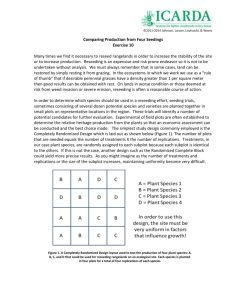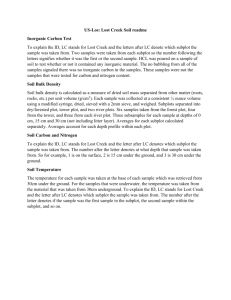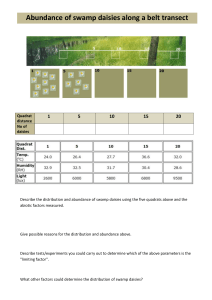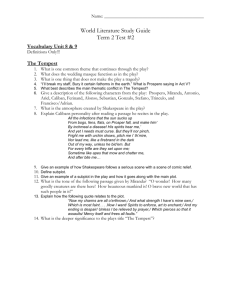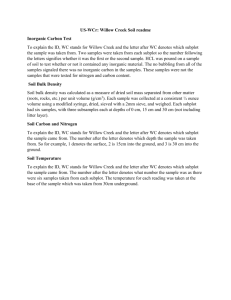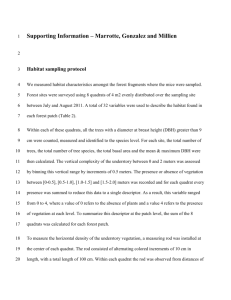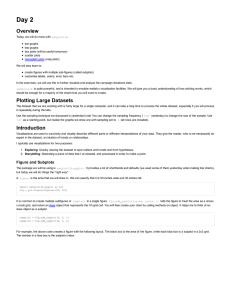Vegetation Diversity and Structure Forest Health Indicator Status and Preliminary Results
advertisement
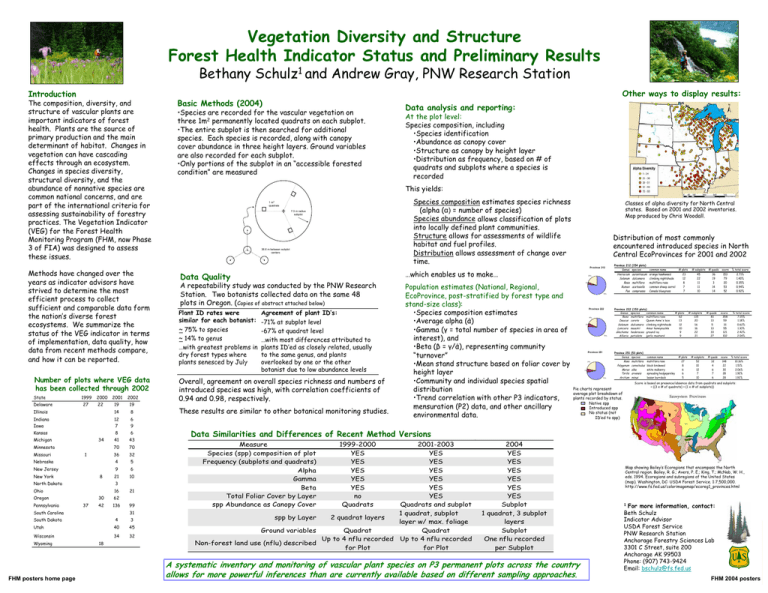
Vegetation Diversity and Structure Forest Health Indicator Status and Preliminary Results Bethany Schulz1 and Andrew Gray, PNW Research Station Introduction The composition, diversity, and structure of vascular plants are important indicators of forest health. Plants are the source of primary production and the main determinant of habitat. Changes in vegetation can have cascading effects through an ecosystem. Changes in species diversity, structural diversity, and the abundance of nonnative species are common national concerns, and are part of the international criteria for assessing sustainability of forestry practices. The Vegetation Indicator (VEG) for the Forest Health Monitoring Program (FHM, now Phase 3 of FIA) was designed to assess these issues. Methods have changed over the years as indicator advisors have strived to determine the most efficient process to collect sufficient and comparable data form the nation’s diverse forest ecosystems. We summarize the status of the VEG indicator in terms of implementation, data quality, how data from recent methods compare, and how it can be reported. Number of plots where VEG data has been collected through 2002 State Delaware 1999 27 2000 22 2001 2002 19 19 Illinois 14 8 Indiana 12 6 Iowa 7 Kansas 9 8 6 41 43 70 70 36 32 Nebraska 4 5 New Jersey 9 6 8 21 10 30 62 42 136 Michigan 34 Minnesota Missouri 1 New York North Dakota 3 Ohio 16 Oregon Pennsylvania 37 South Carolina 31 South Dakota Utah Wisconsin Wyoming FHM posters home page 21 99 18 4 3 40 45 34 32 Other ways to display results: Basic Methods (2004) •Species are recorded for the vascular vegetation on three 1m2 permanently located quadrats on each subplot. •The entire subplot is then searched for additional species. Each species is recorded, along with canopy cover abundance in three height layers. Ground variables are also recorded for each subplot. •Only portions of the subplot in an “accessible forested condition” are measured Data analysis and reporting: At the plot level: Species composition, including •Species identification •Abundance as canopy cover •Structure as canopy by height layer •Distribution as frequency, based on # of quadrats and subplots where a species is recorded This yields: Species composition estimates species richness (alpha (α) = number of species) Species abundance allows classification of plots into locally defined plant communities. Structure allows for assessments of wildlife habitat and fuel profiles. Distribution allows assessment of change over time. 1 m2 quadrats 7.3 m radius subplot 36.6 m between subplot centers Distribution of most commonly encountered introduced species in North Central EcoProvinces for 2001 and 2002 Province 212 …which enables us to make… Data Quality A repeatability study was conducted by the PNW Research Station. Two botanists collected data on the same 48 plots in Oregon. (Copies of abstract attached below) Plant ID rates were similar for each botanist: ~ 75% to species ~ 14% to genus …with greatest problems in dry forest types where plants senesced by July Classes of alpha diversity for North Central states. Based on 2001 and 2002 inventories. Map produced by Chris Woodall. Agreement of plant ID’s: -71% at subplot level -67% at quadrat level …with most differences attributed to plants ID’ed as closely related, usually to the same genus, and plants overlooked by one or the other botanist due to low abundance levels Overall, agreement on overall species richness and numbers of introduced species was high, with correlation coefficients of 0.94 and 0.98, respectively. These results are similar to other botanical monitoring studies. Population estimates (National, Regional, EcoProvince, post-stratified by forest type and stand-size class): •Species composition estimates •Average alpha (ά) •Gamma (γ = total number of species in area of interest), and •Beta (β = γ/ά), representing community “turnover” •Mean stand structure based on foliar cover by height layer •Community and individual species spatial distribution •Trend correlation with other P3 indicators, mensuration (P2) data, and other ancillary environmental data. 20% 4% 76% Province 222 18% 6% 76% Province 251 21% 7% 72% Province 212 Genus Hieracium Solanum Rosa Rumex Poa (154 plots) species aurantiacum dulcamara multiflora acetosella compressa common name orange hawkweed climbing nightshade multiflora rose common sheep sorrel Canada bluegrass Province 222 (153 plots) Genus species common name Rosa multiflora multiflora rose Daucus carota Queen Anne's lace Solanum dulcamara climbing nightshade Lonicera maackii Amur honeysuckle Glechoma hederacea ground ivy Alliaria petiolata garlic mustard Province 251 Genus Rosa Polygonum Morus Torilis Arctium Pie charts represent average plot breakdown of plants recorded by status. Native spp Introduced spp No status (not ID’ed to spp) (53 plots) species multiflora convolvulus alba arvensis minus common name multiflora rose black bindweed white mulberry spreading hedgeparsley lesser burrdock # plots 23 12 8 7 7 # plots 62 13 12 10 9 9 # plots 27 8 6 6 5 # subplots 45 22 11 11 10 # subplots 115 20 16 16 22 21 # subplots 52 10 12 7 10 # quads 36 19 3 14 14 # quads 81 13 5 13 33 27 # quads 32 4 6 7 6 score 153 79 20 53 52 score 358 59 31 55 121 102 score 148 22 30 28 28 % total score 2.71% 1.40% 0.35% 0.94% 0.92% % total score 7.15% 1.18% 0.62% 1.10% 2.42% 2.04% % total score 10.16% 1.51% 2.06% 1.92% 1.92% Score is based on presence/absence data from quadrats and subplots: = ((3 x # of quadrats) + (1 x # of subplots)) Data Similarities and Differences of Recent Method Versions Measure Species (spp) composition of plot Frequency (subplots and quadrats) Alpha Gamma Beta Total Foliar Cover by Layer spp Abundance as Canopy Cover 1999-2000 YES YES YES YES YES no Quadrats 2001-2003 YES YES YES YES YES YES Quadrats and subplot 1 quadrat, subplot spp by Layer 2 quadrat layers layer w/ max. foliage Ground variables Quadrat Quadrat Up to 4 nflu recorded Up to 4 nflu recorded Non-forest land use (nflu) described for Plot for Plot 2004 YES YES YES YES YES YES Subplot 1 quadrat, 3 subplot layers Subplot One nflu recorded per Subplot A systematic inventory and monitoring of vascular plant species on P3 permanent plots across the country allows for more powerful inferences than are currently available based on different sampling approaches. Map showing Bailey’s Ecoregions that encompass the North Central region. Bailey, R. G.; Avers, P. E.; King, T.; McNab, W. H., eds. 1994. Ecoregions and subregions of the United States (map). Washington, DC: USDA Forest Service. 1:7,500,000. http://www.fs.fed.us/colorimagemap/ecoreg1_provinces.html 1 For more information, contact: Beth Schulz Indicator Advisor USDA Forest Service PNW Research Station Anchorage Forestry Sciences Lab 3301 C Street, suite 200 Anchorage AK 99503 Phone: (907) 743-9424 Email: bschulz@fs.fed.us FHM 2004 posters

